火星 月惑星研究会 関西支部 (最新)
ALPO-Japan Latest
Mars Image 2003/08/26(UT)
米山誠一,阿久津弘明,
Clay Sherrod,Antonio Cidadao,Christophe Pellier,Chen Hsun-Hsiao,Brett Turner,Ricardo Nunes,Paulo Casquinha,Guilherme Grassmann,Frank J Melillo,Cristian Fattinnanz,Kolovos Dimitrios,Mario Frassati,Hubble Space Telescope
S.Yoneyama,H.Akutsu,Clay,A.Cidadao,Christophe,Chen.H,B.Turner,Ricardo,P.Casquinha,G.Grassmann,Frank,C.Fattinnanzi,Kolovos,M.Frassati,HST
CM=(6 11 12 14 15 34 18 47 50 55 88 170 177 184 192 199 207 214 231 325 330 336 347 353 357)
解説(安達)
阿久津氏の動画では、北極雲の自転による移動が良く記録されている。この
画像から見る限り、北極地方に見えている雲は遍芯していることが分かる。フラ
ンク・メリッロ(Frank J Melillo)氏の画像には閃光らしき模様の記載があるが、
これは画像の処理段階で出てきたものと考えられる。同じ画像を良く見ると、同
じような写り方をしている部分が何ケ所もあることが分かる。(reported by 13
observers)
August 26th, 2003
At the movie of Akutsu, the cloud of NPR should move with the rotation
and it understands it. As for the cloud of NPR, it finds that a center
is shifted from this image. There is a record like Frash in the image
of Frank J Merlillo but it thinks that this was made in the process of
the processing. When seeing the same frame, some places to be doing
the way of falling which is similar are seen.
FROM Makoto ADACHI
-------------------------------------------------------------------------------------
|
Seiichi Yoneyama(200mm F4 Newton,ToUcam PRO)
|
|
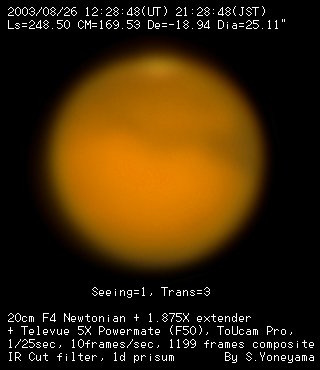
天気予報では曇りのち雨でしたが、
日没後晴れ間が広がりだし、火星も
雲に見え隠れする状態で、21時半頃に
撮影が可能な状態になりました。
1回撮影したら西から近づいた雲に
隠されてしまいました。
今日もシーイングが極度に悪く火星像は
アメーバーの如くフニャフニャでした。
≪神奈川県横浜市 米山誠一≫
|
Hiroaki Akutsu(280mm Newtonian)
|
|
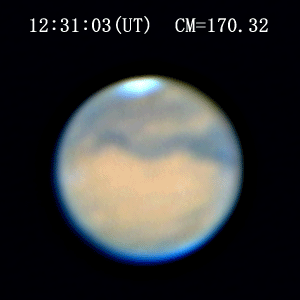
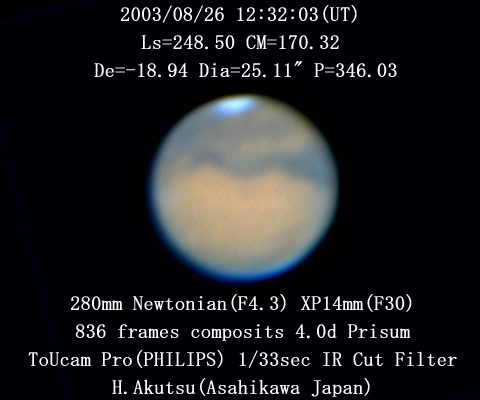
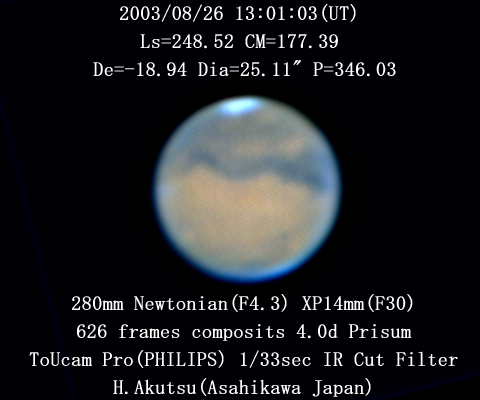

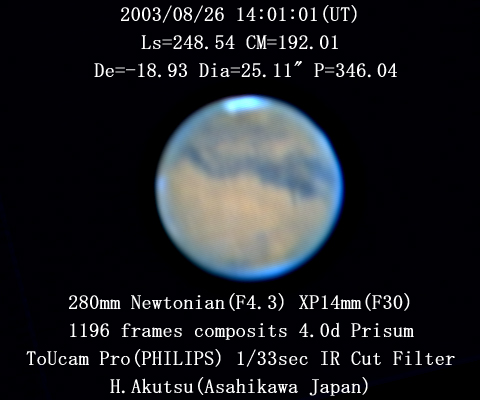
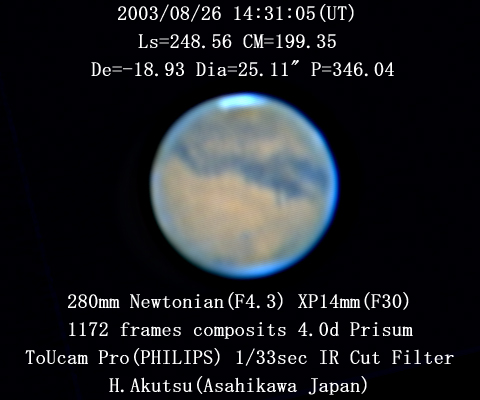

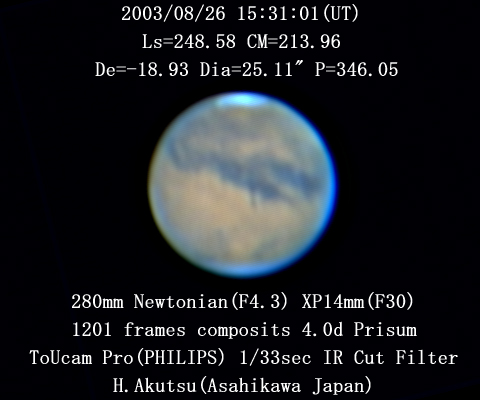
≪北海道旭川市 阿久津弘明≫
|
Dr. P. Clay Sherrod (410mm SC : ToUcam PRO)
|
|
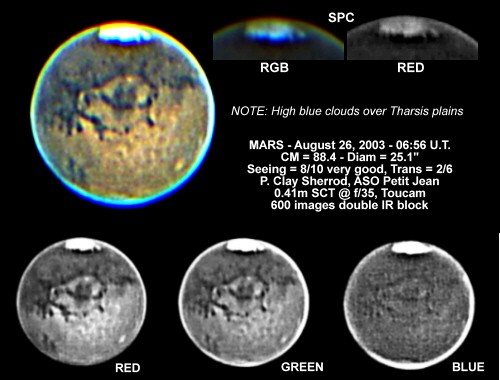
Good morning to all....
A brilliant reddish flash was recorded on these ASO images from Aug. 26, centered on the planet at nearly 06:56 UT; the scintillating bright red spot can be seen in all RGB images but is most prominent in Red and the combined RGB image; it is located on the southern perimeter of the dark Solis Lacus, just above center in the images.
[Dr. P. Clay Sherrod Arkansas State U.S.A]
|
Antonio Cidadao (250mm LX200SCT : FLICM7 1E CCD camera)
|
|
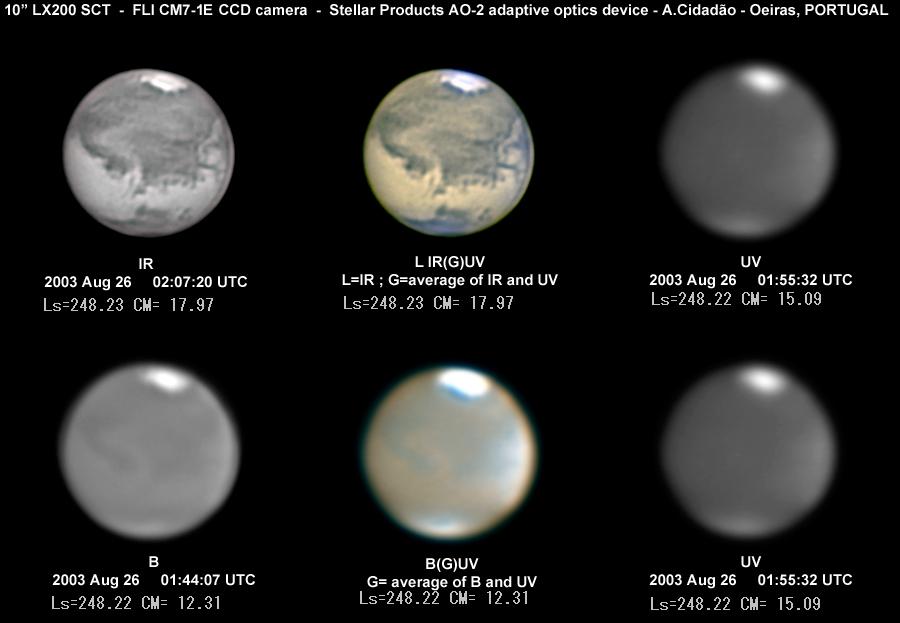
Hi all
Here is another Mars image, this time also including UV data to give better
contrast to the clouds (in contrast to the double IR-blocked Blue filter, no
albedo features were seen in UV images). Also, a B-UV pseudo color image is
also shown to depict this.
Time data is mid-exposure for each channel. IR=broadband near IR
(830-1000nm); UV= broadband near UV (320-390nm); B= blue astronomik type II
filter, stacked with astronomick IR-block filter. individual integrations
were 10sec for the B image, 15sec for IR and 60sec for UV. Original
sampling. Steady skies...
≪アントニオ シダダオ ポルトガル≫
[Antonio Cidadao Oeiras - Portugal]
|
Christophe Pellier (180mm Newtonian webcam Toucam Pro)
|
|
 Hi observers : last night I have seen the quality of the seeing passing from
very poor to fair or even fairly good in just a matter of minutes :-o. I
think however that because of my fear of the clouds I have adopted uncorrect
parameters for the RGB images which are too noisy.
The morning haze is very bright, however.
[Christophe Pellier Bruz City , France]
Hi observers : last night I have seen the quality of the seeing passing from
very poor to fair or even fairly good in just a matter of minutes :-o. I
think however that because of my fear of the clouds I have adopted uncorrect
parameters for the RGB images which are too noisy.
The morning haze is very bright, however.
[Christophe Pellier Bruz City , France]
|
Chen Hsuan-Hsiao ( 200mm VC200L Philips ToUcam Pro)
|
|
 [Chen Hsuan-Hsiao : Kaohsiung Taiwan R.O.C]
[Chen Hsuan-Hsiao : Kaohsiung Taiwan R.O.C]
|
Brett Turner (Meade Archromat Refractor 152mm)
|
|
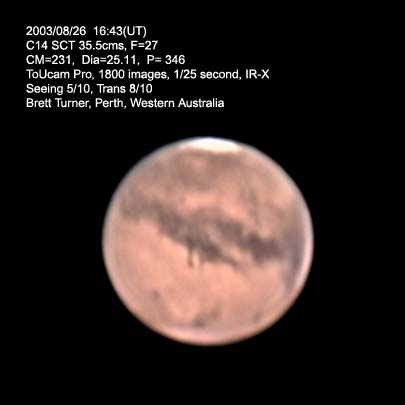
2003/08/26 16:43(UT)
C14 SCT 35.5cms, F=27
CM=231, Dia=25.11, P= 346
ToUcam Pro, 1800 images, 1/25 second, IR-X
Seeing 5/10, Trans 8/10
Planet's surface stills looks fairly clear in comparison to the previous night's image. I am now processing the images with the new version of Registax, Version 2.
Regards
[Brett Turner, Perth Western Australia]
|
Ricardo Nunes(Celestron C8 Quickcam VideoCamera )
|
|
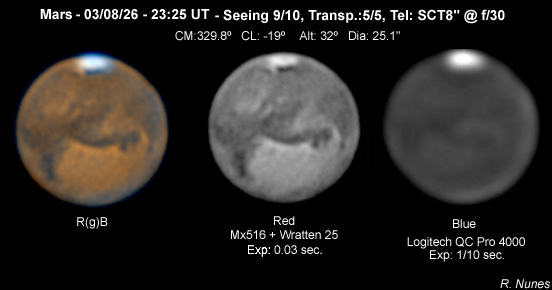
very good seeing.
[Ricardo Nunes : Lisbon, Portugal]
|
Paulo Casquinha ( 200mm f/5 Newton Reflector Toucam Pro)
|
|
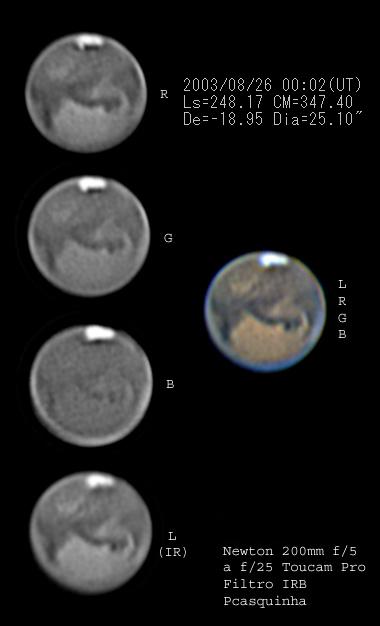
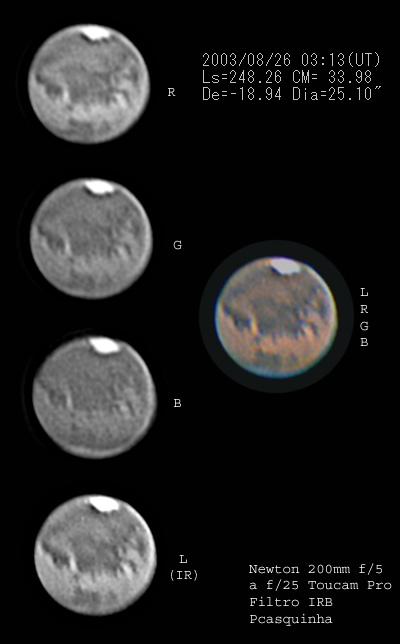 (site: 38.567 N /8.933 W Alt 124 m)
[Paulo Casquinha Palmela, Portugal]
(site: 38.567 N /8.933 W Alt 124 m)
[Paulo Casquinha Palmela, Portugal]
|
Guilherme Grassmann (8" F6 Newtonian Philips Vesta Pro)
|
|
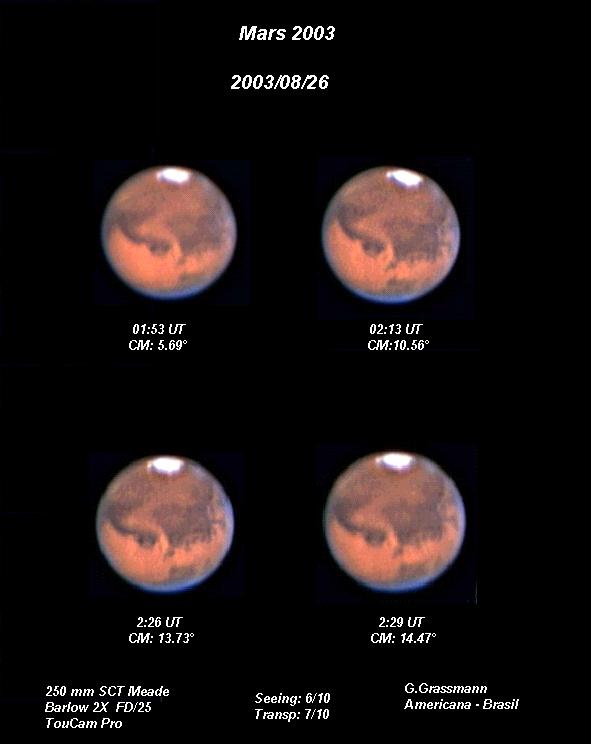
Hello All!
Very intense blue haze on NPC and West side of the planet.
Regards
[Guilherme Grassmann, Americana-San Paulo, Brasil]
|
Frank J Melillo(Celestron 203mm Schmidt Starlight Xpress MX-5)
|
|
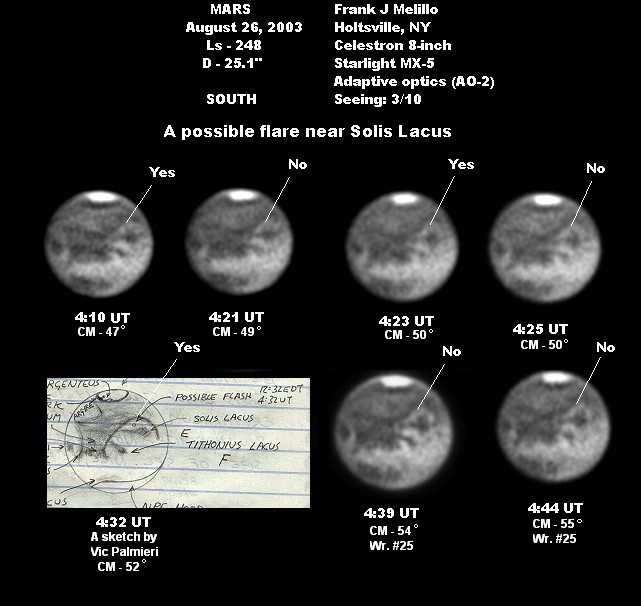
A possible flash near Solis Lacus?
Dear all
I have attached a montage of all my images of Mars on the 26th of August. Once again, there was a possible flash at 4:10 UT and 4:23 UT. All other images are seen with no flash. The location was at "10 o'clock " position of Solis Lacus. Also, Vic Palmieri had seen it too at 4:32 UT and his sketch is included with my montage. It looks pretty convincing that it was captured or something was there.
Please, let me know if this is reality. This montage is not posted yet on the website.
[Frank J Melillo Holtsville NY U.S.A]
|
Cristian Fattinnanzi ( 250mm Newtonian Philips Vesta Pro)
|
|
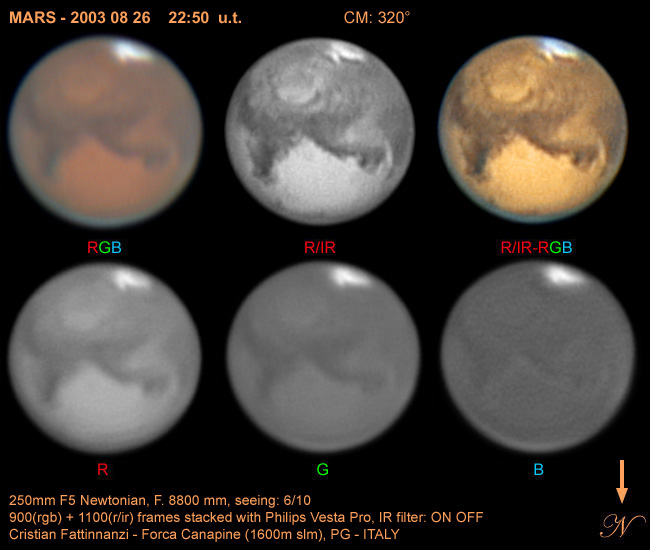 [Cristian Fattinnanzi : Macerata ITALY]
[Cristian Fattinnanzi : Macerata ITALY]
|
Kolovos Dimitrios ( 280mm SCT : Philips ToUcam pro)
|
|
 [Kolovos Dimitrios , Athens Greece]
《コロボス デミトゥリオス ギリシャ アテネ》
[Kolovos Dimitrios , Athens Greece]
《コロボス デミトゥリオス ギリシャ アテネ》
|
Mario Frassati(Drawing:203mm F10 SCT)
|
|

[ Mario Frassati Crescentino (VC) ITALY ]
|
Hubble Space Telescope(2900mm fl=5300mm)
|
South up South up  Original tif image 800X800 1884kb Original tif image 800X800 1884kb
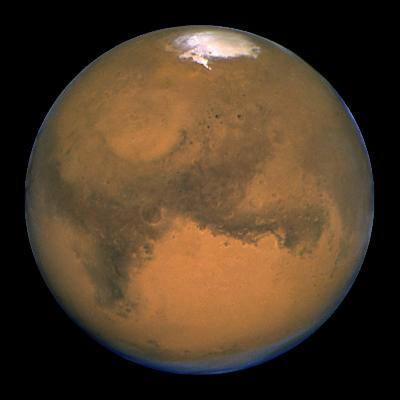
NASA's Hubble Space Telescope took this close-up of the red planet Mars when it was just 34,648,840 miles (55,760,220 km) away. This color image was assembled from a series of exposures taken between 6:20 p.m. and 7:12 p.m. EDT Aug. 26 with Hubble's Wide Field and Planetary Camera 2. The picture was taken just 11 hours before the planet made its closest approach to Earth in 60,000 years.
Many small, dark, circular impact craters can be seen, attesting to the Hubble telescope's ability to reveal fine detail on the planet's surface. One of the most striking is the 270-mile- (450-km-) diameter Huygens crater, seen near the centerof the image.
The two dominant dark swatches seen on this part of the planet are classical regions labeled by early Mars observers. The "shark-fin" shape to the right is Syrtis Major. The horizontal lane to the left is Sinus Meridani. One of NASA's Mars Exploration Rovers, named "Opportunity," will land at the western end of this region in January 2004.
The picture shows that it is a relatively warm summer on Mars, as evident in the lack of water-ice clouds at mid-latitude, and the receding southern polar cap. Ice on the rugged topography gives a somewhat ragged, scalloped look. Up north, at the top of the disk where it is Martian winter, a frigid polar hood of clouds covers the northern polar cap and surrounding region.
Even in the relatively balmy Southern Hemisphere, daytime highs are just above freezing in the Hellas impact basin, the circular feature near the image center. Hellas is nearly 5 miles deep (8 km). Hellas is like Death Valley ? except that Mars is much drier than even Death Valley. Having a diameter of 1,100 miles (1,760 km), Hellas was formed when an asteroid slammed into Mars billions of years ago. Many summer dust storms originate in this basin, though it is remarkably clear of dust in this Hubble image.
Mars and Earth have a "close encounter" about every 26 months. These periodic encounters are due to the differences in the two planets' orbits. Earth goes around the Sun twice as fast as Mars, lapping the red planet about every two years. Both planets have elliptical orbits, so their close encounters are not always at the same distance. In its close encounter with Earth in 2001, for example, Mars was about 9 million miles farther away. Because Mars will be much closer during this year's close approach, the planet appears 23 percent bigger in the sky.
This photograph is a color composite generated from observations taken with blue, green, and red filters. The resolution is 8 miles (12 km) per pixel.
Credit: NASA, J. Bell (Cornell U.) and M. Wolff (SSI)
[NASA/JPL/Space Science Institute]
 ALPO-Japan Latest ALPO-Japan Latest

 Mars Section Mars Section
|
 Hi observers : last night I have seen the quality of the seeing passing from
very poor to fair or even fairly good in just a matter of minutes :-o. I
think however that because of my fear of the clouds I have adopted uncorrect
parameters for the RGB images which are too noisy.
The morning haze is very bright, however.
[Christophe Pellier Bruz City , France]
Hi observers : last night I have seen the quality of the seeing passing from
very poor to fair or even fairly good in just a matter of minutes :-o. I
think however that because of my fear of the clouds I have adopted uncorrect
parameters for the RGB images which are too noisy.
The morning haze is very bright, however.
[Christophe Pellier Bruz City , France]










 [Chen Hsuan-Hsiao : Kaohsiung Taiwan R.O.C]
[Chen Hsuan-Hsiao : Kaohsiung Taiwan R.O.C]


 (site: 38.567 N /8.933 W Alt 124 m)
[Paulo Casquinha Palmela, Portugal]
(site: 38.567 N /8.933 W Alt 124 m)
[Paulo Casquinha Palmela, Portugal] 

 [Cristian Fattinnanzi : Macerata ITALY]
[Cristian Fattinnanzi : Macerata ITALY] [Kolovos Dimitrios , Athens Greece]
《コロボス デミトゥリオス ギリシャ アテネ》
[Kolovos Dimitrios , Athens Greece]
《コロボス デミトゥリオス ギリシャ アテネ》

 Original tif image 800X800 1884kb
Original tif image 800X800 1884kb 
 ALPO-Japan Latest
ALPO-Japan Latest
